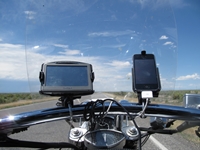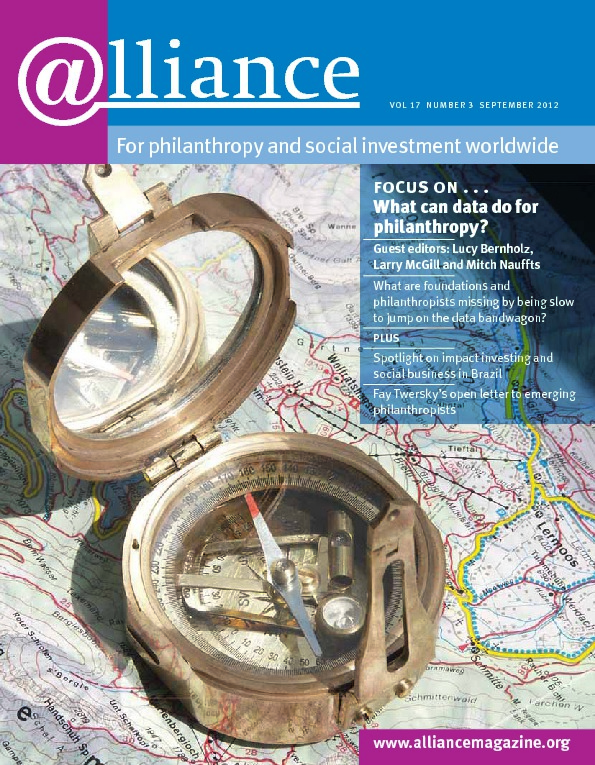Once upon a time we used paper maps to plan our road trips. Then came GPS systems, which were at first installed only in the most expensive cars. Then GPS became commonplace and even came in our phones. Now, many of us enter an address, get behind the wheel, and follow turn-by-turn directions presented to us by an ever-patient, automated voice coming from the dashboard.
Some of us might impose our own preferences on the GPS, setting it to avoid highways or stay off private roads. Others will simply ignore part of the directions, allowing ‘her’ to keep ‘recalculating route’ until we get past the part of the trip where we already know how we want to go. Fewer and fewer of us are actually unfolding a map, tracing different possibilities with our fingers, and pulling over to the side of the road to choose an alternative route when the scenery gets boring.
That’s what data have done to driving. We’ve subtly shifted our role from route planner to direction follower. Most of us are happy with this change – we get where we wanted to go with fewer headaches (and we never have to try to refold the map).
When data become the GPS of our philanthropy …
 Imagine what philanthropy and social investing will look like when they really get built around data. There’s been great discussion and progress made in using data in philanthropy, and this edition of Alliance gives plenty of examples, tools and discussion about the pros and cons. But we’re still at the stage of adding data to existing practices. We haven’t yet started to see new practices emerge out of existing data. When that starts to happen, when data become the GPS of our philanthropy, we’ll see some big changes just as we have in other fields.
Imagine what philanthropy and social investing will look like when they really get built around data. There’s been great discussion and progress made in using data in philanthropy, and this edition of Alliance gives plenty of examples, tools and discussion about the pros and cons. But we’re still at the stage of adding data to existing practices. We haven’t yet started to see new practices emerge out of existing data. When that starts to happen, when data become the GPS of our philanthropy, we’ll see some big changes just as we have in other fields.
Here are two quick analogies. Publishing is being remade by data. Authors are going straight to readers via online publishing platforms that focus on search engine optimization, integrate video and audio into texts, re-size long articles and publish them as ‘singles’. Stories sell for 99 cents. Online sales offer incredible data on readers, where and who they are, how they found the article, where they went next. News organizations and other online publishers proudly promote their ‘most emailed articles’. All of this is changing not just business models but what gets written, what gets read, and what gets talked about.
Medical research is another example. For centuries we’ve relied on the ‘scientific method’ of hypothesis – experiment – analysis – hypothesis. Now, massive data sets of diagnostic information, chemical trials, tissue registries and patients’ testimonies are being combined and mined and algorithms are being used to search for patterns before any kind of hypothesis is generated. Drugs designed for one disease may fail dismally in their original sphere but be a breakthrough success in an otherwise unrelated field. Not only are the resulting pharmaceutical protocols different, the whole scientific method is changing.
Drawing from and contributing to a common store
When we try to imagine what data will mean for philanthropy, we need to switch the order of things. We’re coming from an age in which discrete philanthropic preferences have trumped shared action. In the age of data, collective sets of information will come first and individual philanthropists will tap into it. In the future there will be treasure troves of accessible, usable data on everything from poverty to illness, cultural performance to environmental indicators, child welfare to human rights, commodities prices to market locations. Anyone with a mobile phone will be able to tap into these. Individuals will be able to use this information to find opportunities for volunteering, giving or investing. They will contribute to these data sets with location-based check-ins and social network status updates. Institutions will be able to combine and visualize subsets of these data according to their own stated interests, slicing, dicing, recombining and contributing their findings back to the shared storehouses. From within these commonly shared, curated and cleaned, and constantly updated storehouses of bits and bytes, philanthropic institutions will pull down what they need, query and model according to their interests, and automatically share again for others to consume.
Similarly, data on impact investing, public funding, corporate social responsibility contributions and philanthropic giving will be available, comparable and mixable. Mapping revenue flows by issue, geography, intent and source will be an easy first step before planning one’s resource allocation. Even before this has happened we can see how readily available data ease the creation of shared metrics and thus make possible the comparisons and exchanges necessary for impact investing. What will happen when turning to data first is the natural first step in all private resource allocation? When working from shared data becomes as much second nature as typing an address into the GPS, we will start to see real change in philanthropic practice.
In the world of online data
Passion and personal interests won’t disappear – they will just operate in a different environment. Abundant, accessible and meaningful data aren’t going to change human nature, but they may well change reporting requirements, expectations of success and ease of joint action. Which may well, in time, shift patterns of human behaviour about giving time, money and expertise.
In the world of online data, information and money take the same form (electronic bits) so it’s easier to imagine individual donors piggybacking on the research of big funders while also crowdfunding discrete projects as a habit, not just as a special event. Flash mobs of ‘doers’ and ‘donors’ who can find each other and the information they need with their mobile phones (which now outnumber people on the planet) will come together, make something happen, and move on to the next network. We may make institutions of these kinds of relationships and invent new forms of governance to demonstrate their reliability or hold others accountable. Privacy concerns about personal data will have already changed laws and corporate practice so that each of us knows we own our data in the same way we own our clothes. We might lend the data on a one-time basis for economic research or donate it in perpetuity to science, making data a philanthropic asset as well as an input and output. Finally, we may recognize the public value of philanthropically funded data, and change our regulations to value the data and access to them. No longer will we discuss philanthropy first and foremost in terms of dollars donated but we will also consider wisdom and knowledge generated.
The discussions philanthropy needs to have
Not everything about the digital data future is good or even better than what we have now. Nor will data, any more than any other technological innovation, be distributed evenly or be free from abuse. The challenges and problems of big data are as big as the data themselves. And so too are the opportunities. The truth is, we don’t know what it means to live in a world where information about us, in ever finer particles, is stored for ever longer periods of times by ever more distant enterprises.
I don’t know when this future will come but I do know this – people who have grown up with digital data – massive, connected, searchable, mixable, always available data – are going to shape the philanthropic fortunes and practices of this century. The discussions about ownership, privacy, governance, borders, security and innovation that are taking place now in industries like publishing, at multilateral organizations like the World Bank, and among governments from Brazil to Kenya, are the very same ones that philanthropy needs to have.
Lucy Bernholz is managing director of Arabella Advisors and author of the award-winning blog philanthropy2173.com. She is a guest editor for the Alliance special feature ‘What can data do for philanthropy?’ Email lucy@lucybernholz.com.





Comments (0)